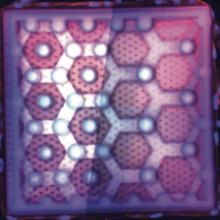Precision 3D-Printed Cell Scaffolds Mimicking Native Tissue Composition and Mechanics
A. Erben, M. Hörning, B. Hartmann, T. Becke, S.A. Eisler, A. Southan, S. Cranz, O. Hayden, N. Kneidinger, M. Königshoff, M. Lindner, G.E.M. Tovar, G. Burgstaller, H. Clausen-Schaumann, S. Sudhop and M. Heymann
Advanced Healthcare Materials, 200918, 2020
doi : 10.1002/adhm.202000918
Brief Summary: ''Cellular dynamics are modeled by the 3D architecture and mechanics of the extracellular matrix (ECM) and vice versa. These bidirectional cell-ECM interactions are the basis for all vital tissues, many of which have been investigated in 2D environments over the last decades. Experimental approaches to mimic in vivo cell niches in 3D with the highest biological conformity and resolution can enable new insights into these cell-ECM interactions including proliferation, differentiation, migration, and invasion assays. Here, two-photon stereolithography is adopted to print up to mm-sized high-precision 3D cell scaffolds at micrometer resolution with defined mechanical properties from protein-based resins, such as bovine serum albumin or gelatin methacryloyl. By modifying the manufacturing process including two-pass printing or post-print crosslinking, high precision scaffolds with varying Young’s moduli ranging from 7-300 kPa are printed and quantified through atomic force microscopy. The impact of varying scaffold topographies on the dynamics of colonizing cells is observed using mouse myoblast cells and a 3D-lung microtissue replica colonized with primary human lung fibroblast. This approach will allow for a systematic investigation of single-cell and tissue dynamics in response to defined mechanical and bio-molecular cues and is ultimately scalable to full organs. ''


